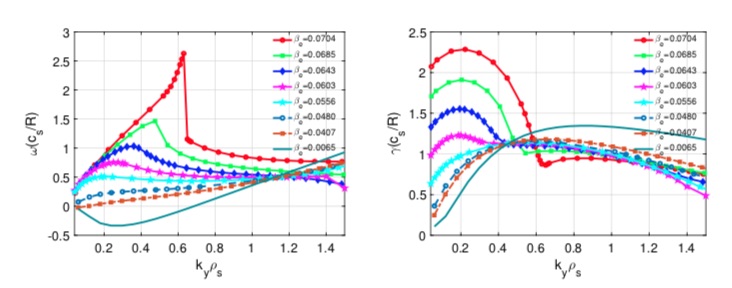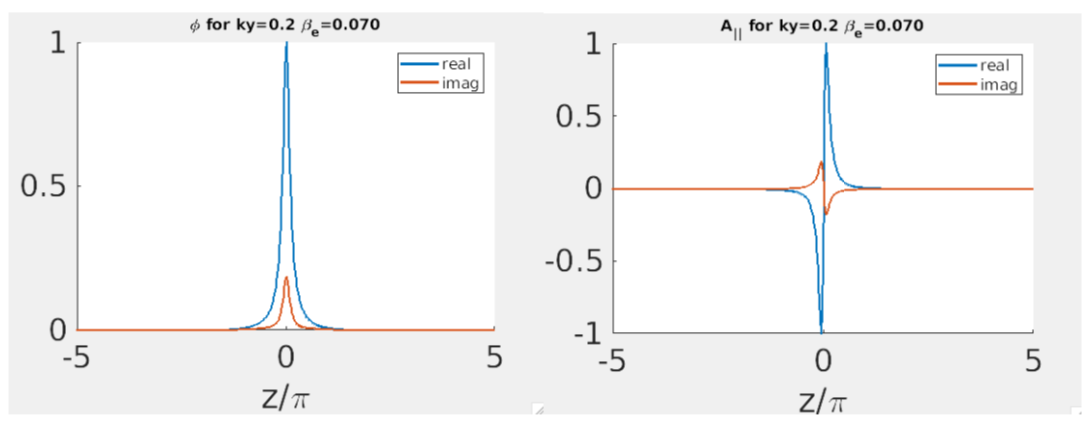Speakers
Description
Spherical tokamaks have small aspect ratio allowing higher β stability limit 1. The design of spherical tokamak offers higher elongation and also enables to hold higher current. Due to the fact that these machines can potentially offer better performance than the conventional tokamaks, they have gained a lot of interest as a fusion power reactor as well as a rich neutron source [1, 2, 3]. The high β environment in spherical tokamaks or reactors naturally makes them propitious for the onset of electromagnetic modes such as the kinetic ballooning modes (KBM) [4]. The spherical tokamak might operate in a parameter space near the threshold for the electrostatic to electromagnetic transition, more specifically, from ITG/TEM to KBM transition. In the low wavelength limit the modes might be quite global compared to the minor radius of the system. There are several interesting questions to address. For example, what happens near the regime when long wavelength modes go unstable first which might change the threshold beta; how these long wavelength modes couple with short wavelength modes; how these modes affect the absolute gradient limit in the transport barriers, etc. The nature of such a transition is presently unclear as it involves long-wavelength modes where the global physics and energetic particles may play a critical role. This is particularly an issue for spherical tokamak reactors, for example, the proposed STEP, which have very high target β
values.
In the present work, we aim to address some of such concerns. We study the properties of the KBM in the long wavelength limit. We investigate the transition from electrostatic ITG/TEM turbulence to inherently electromagnetic KBM turbulence with a view to understand the high-β fusion reactor plasmas using gyrokinetic simulations. For the purpose, we generate a set of MAST-geometry reference spherical tokamak equilibria using the equilibrium code CHEASE [5] with varying peak β values. The nature of the most unstable modes is then studied using gyrokinetic simulations with GENE [6]. The KBM properties are studied for purely temperature gradient and purely density gradient driven limits and compared. The real frequency and growth rates for the density gradient driven cases are shown in the Fig.1. The real frequencies vs k_y ρ_s are shown in the left panel for different values of electron β. Each value of electrons β corresponds to a different equilibrium. Other equilibrium quantities used

in the simulations correspond to local values in the core around r/a=0.5. The right panel in Fig. 1 shows the corresponding growth rates. It is clear that at higher values of β, the modes are more unstable at long wavelengths while at lower values of β the modes tend to peak at shorter wavelengths. The mode structure for the highest β case is shown in Fig. 2 for k_y ρ_s~0.2. The potentials ϕ and A_|| in the extended ballooning angle are plotted in the left and right panels of the figure B_|| not shown). It is evident from the figure that the mode exhibits ballooning character. We also calculate the parallel electric field E_|| and observe that it is quite small compared to the inductive component suggesting that the mode is of ideal MHD nature at long wavelengths. This fact is further corroborated by comparing the growth rates with local MHD

stability calculation [7]. The real frequencies are comparable to ω_pi/2, where, ω_pi, is diamagnetic drift frequency, in the long wavelength limit which diverge for shorter wavelength modes and also for the lower beta cases. Interestingly, although the growth rate for the unstable KBM modes peaks around k_y ρ_s~0.2, the growth rate is not much lower at k_y ρ_s~0. This might be problematic for local and quasilinear theory. A comparison with global calculations might address this issue. We investigate the same using the global code ORB5 [8]. Effect of plasma shape on the instability is studied, which shows that shaping effect is stabilizing for the mode. The long wavelength modes are found to interact strongly with the fast particles in the system. The effect of fast ions on the mode properties will be presented. Finally, nonlinear simulations will be presented using GENE in order to study the transition of turbulence from electrostatic regime to electromagnetic regime in the presence of the long wavelength modes. We will report how the threshold β for such a transition is affected in the presence of the long wavelength modes.
This work is supported by the EUROfusion - Theory and Advanced Simulation Coordination and has been carried out within the framework of the EUROfusion Consortium and has received funding from the Euratom research and training programme 2014-2018 and 2019-2020 under grant agreement No 633053. The views and opinions expressed herein do not necessarily reflect those of the European Commission. It is also supported by EPSRC grant no EP/R034737/1.
References:
1 Ono et al, Phys. Plasmas 22, 040501 (2015) 2 Menard et al., Nucl. Fusion 56, 106023 (2016), [3] Sykes et al., Nucl. Fusion 58, 016039 (2018) [4] Tang et al., Nucl. Fusion 20 1439, (1980). [5] Luetjens et al., Comput. Phys. Commun. 97 219, (1996) [6]Go ̈rler et al., J. Comput. Phys. 230(18), 7053 (2011) [7] Greene et al., Nucl. Fusion 21 453 (1981) [8]Jolliet et al., Comput. Phys. Commun. 177 (5) (2007).
| Affiliation | University of Warwick, Coventry, CV47AL, UK |
|---|---|
| Country or International Organization | United Kingdom |
